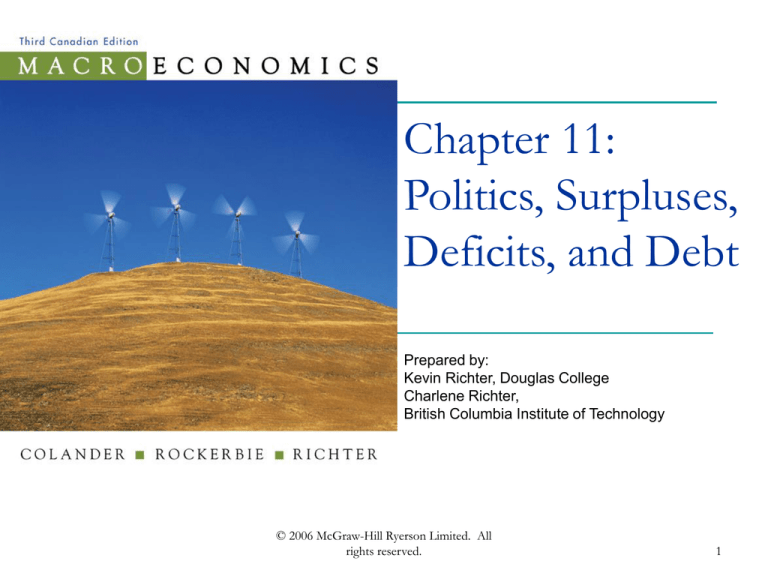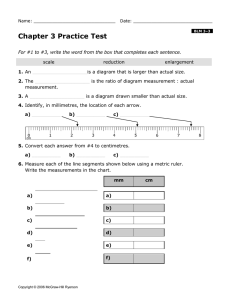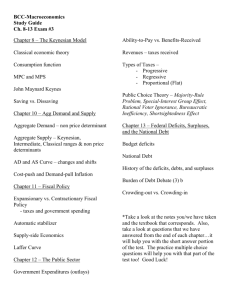
Chapter 11:
Politics, Surpluses,
Deficits, and Debt
Prepared by:
Kevin Richter, Douglas College
Charlene Richter,
British Columbia Institute of Technology
© 2006 McGraw-Hill Ryerson Limited. All
rights reserved.
1
Defining Surpluses and Debt
A surplus is an excess of revenues over
payments.
A deficit is a shortfall of revenues relative to
payments.
© 2006 McGraw-Hill Ryerson Limited. All
rights reserved.
2
Introduction
After having run budget deficits for many
decades, in 1997 the federal government
began to run budget surpluses.
© 2006 McGraw-Hill Ryerson Limited. All
rights reserved.
3
Introduction
In the long-run framework, surpluses have
both desirable and undesirable effects.
Surpluses are good because they provide
additional saving that can be used to boost
Investment.
This assumes that the government does it
better than the private sector.
© 2006 McGraw-Hill Ryerson Limited. All
rights reserved.
4
Introduction
Deficits are good because they allow the
economy to maintain a level of GDP at or
beyond its potential.
If the economy is running below its potential
output, deficits can be used to stimulate the
economy.
© 2006 McGraw-Hill Ryerson Limited. All
rights reserved.
5
Introduction
If the economy is booming, surpluses can be
used to pay down the debt.
© 2006 McGraw-Hill Ryerson Limited. All
rights reserved.
6
Financing the Deficit
The government finances its deficit by selling
bonds to private individuals and to the central
bank.
Bonds – promises to pay back the money in
the future.
© 2006 McGraw-Hill Ryerson Limited. All
rights reserved.
7
Financing the Deficit
A central bank is able to print money to buy
its government’s bonds.
Potentially, the central bank can print an
unlimited amount of money to buy bonds.
Printing too much money means inflation
which can have a negative effect on the
economy.
© 2006 McGraw-Hill Ryerson Limited. All
rights reserved.
8
Defining Surpluses and Deficits
Whether a nation has a deficit depends on
what is included as a revenue and what is
included as an expenditure.
This accounting issue is central to the debate
about whether we should be concerned about
a deficit.
© 2006 McGraw-Hill Ryerson Limited. All
rights reserved.
9
Defining Surpluses and Deficits
The Retirement Income system is based on
promises to pay.
Retirement Income System - social insurance
programs that provide financial benefits to the
elderly and disabled and to their eligible
dependents and/or survivors.
© 2006 McGraw-Hill Ryerson Limited. All
rights reserved.
10
Deficits and Surpluses as Summary
Measures
As a summary, a surplus or deficit figure
reduces a complicated set of accounting
relationships down to a single figure.
To understand the summary, you must
understand the methods that were used to
calculate it.
© 2006 McGraw-Hill Ryerson Limited. All
rights reserved.
11
Deficits and Surpluses as Summary
Measures
What is important is not whether a budget is
in surplus or deficit; what is important is the
economic health of the economy.
© 2006 McGraw-Hill Ryerson Limited. All
rights reserved.
12
Nominal and Real Surpluses and
Deficits
A nominal deficit is determined by looking at
the difference between expenditures and
receipts.
A real deficit is the nominal deficit adjusted
for inflation.
© 2006 McGraw-Hill Ryerson Limited. All
rights reserved.
13
Nominal and Real Surpluses and
Deficits
Inflation reduces the value of the debt.
The larger the debt and the larger the
inflation, the more debt will be eliminated by
inflation.
© 2006 McGraw-Hill Ryerson Limited. All
rights reserved.
14
Nominal and Real Surpluses and
Deficits
The real deficit is calculated by adjusting the
nominal deficit for inflation.
Real deficit =
Nominal deficit – (Inflation x Total debt)
© 2006 McGraw-Hill Ryerson Limited. All
rights reserved.
15
Nominal and Real Surpluses and
Deficits
The lowering of the real deficit by inflation is
not costless to the government.
Persistent inflation gets built into expectations
and causes higher interest rates.
© 2006 McGraw-Hill Ryerson Limited. All
rights reserved.
16
Structural and Passive Surpluses and
Deficits
Not all government expenditures are
independent of the level of income in the
economy.
The budget deficit could result from policies
designed to affect the economy or from
income deviating from its potential.
© 2006 McGraw-Hill Ryerson Limited. All
rights reserved.
17
Structural and Passive Surpluses and
Deficits
A structural deficit or surplus – the part of
the budget deficit or surplus that would exist
even if the economy were at its potential level
of income.
© 2006 McGraw-Hill Ryerson Limited. All
rights reserved.
18
Structural and Passive Surpluses and
Deficits
A passive deficit or surplus is the part of
the deficit or surplus that exists because the
economy is operating below or above its
potential level of output.
The passive deficit is also known as the
cyclical deficit.
© 2006 McGraw-Hill Ryerson Limited. All
rights reserved.
19
Structural and Passive Surpluses and
Deficits
When an economy is operating above its
potential, it has a passive surplus.
If the economy is operating below its
potential, the actual deficit would be larger
than the structural deficit.
© 2006 McGraw-Hill Ryerson Limited. All
rights reserved.
20
Structural and Passive Surpluses and
Deficits
There is a significant debate about what is an
economy’s potential income level.
There is disagreement about what
percentage of a deficit is structural and what
percentage is passive.
© 2006 McGraw-Hill Ryerson Limited. All
rights reserved.
21
© 2006 McGraw-Hill Ryerson Limited. All
rights reserved.
22
Judging Debt Relative to Assets
When the government runs a deficit, it might
be spending on projects that increase its
assets.
If the assets are valued at more than their
costs, then the deficit is making the society
better off.
© 2006 McGraw-Hill Ryerson Limited. All
rights reserved.
23
Defining Debt and Assets
Defining debt and assets can be arbitrary.
As was the case with income, revenues, and
deficits, there is no perfect answer as to how
assets and debt should be valued.
© 2006 McGraw-Hill Ryerson Limited. All
rights reserved.
24
Defining Debt and Assets
Even after assets are taken into account, you
still have to be careful when deciding whether
or not to be concerned about debt.
© 2006 McGraw-Hill Ryerson Limited. All
rights reserved.
25
Arbitrariness in Defining Debt and
Assets
The total stock of gross debt can be broken
down into market debt and non-market debt.
Market debt includes marketable bonds,
treasury bills and other securities.
Non-market debt includes federal public
sector pension liabilities and other federal
liabilities.
© 2006 McGraw-Hill Ryerson Limited. All
rights reserved.
26
Arbitrariness in Defining Debt and
Assets
To calculate debt, we add market debt and
non-market debt, and subtract the value of
financial assets held by the government, such
as cash, reserves, and loans.
© 2006 McGraw-Hill Ryerson Limited. All
rights reserved.
27
Difference Between Individual and
Government Debt
Government debt is different from an
individual’s debt for three reasons:
Government debt is ongoing – it does not die.
Government can print money to pay off its debt –
individuals can’t.
82 percent of government debt is internal debt –
debt owed to other government agencies or to its
citizens.
© 2006 McGraw-Hill Ryerson Limited. All
rights reserved.
28
Difference Between Individual and
Government Debt
Paying interest on the internal debt involves a
redistribution among citizens of the country.
It does not involve a net reduction in income
of the average citizen.
© 2006 McGraw-Hill Ryerson Limited. All
rights reserved.
29
Difference Between Individual and
Government Debt
External debt is more like an individual’s
debt.
External debt – government debt owed to
individuals in foreign countries.
© 2006 McGraw-Hill Ryerson Limited. All
rights reserved.
30
Deficits and Debt: Historical Record
Most economists do not look at absolute
figures of deficits and debt.
They are much more concerned with deficits
and debt relative to GDP.
© 2006 McGraw-Hill Ryerson Limited. All
rights reserved.
31
Deficits and Debt: Historical Record
Deficits and debt relative to GDP rose
significantly in the 1970s and 1980s.
By 1995, net debt was nearly 70% of GDP.
In the late 1990s debt started to fall, reaching
50% of GDP in 2001, and 41% in 2004.
© 2006 McGraw-Hill Ryerson Limited. All
rights reserved.
32
Deficits and Debt: Historical Record
Deficits and debt relative to GDP provide a
measure of a country’s ability to pay off a
deficit and service its debt.
© 2006 McGraw-Hill Ryerson Limited. All
rights reserved.
33
Debt as a Percentage of GDP
© 2006 McGraw-Hill Ryerson Limited. All
rights reserved.
34
Debt Burden
Most of the decrease in the debt-to-GDP ratio
occurred through growth in GDP.
When GDP grows, the government can
reasonably handle more debt.
© 2006 McGraw-Hill Ryerson Limited. All
rights reserved.
35
Debt Burden
Real growth in Canada has averaged about
2.5-3.5 percent a year.
This means that the debt can grow between
2.5-3.5 percent a year without increasing
debt/GDP ratio.
© 2006 McGraw-Hill Ryerson Limited. All
rights reserved.
36
Canada’s Debt Relative to Other
Countries
Canada’s debt is moderately large relative to
other high income OECD countries.
Canada’s debt has fallen substantially since
1998.
© 2006 McGraw-Hill Ryerson Limited. All
rights reserved.
37
Canada’s Debt Relative to Other
Countries
© 2006 McGraw-Hill Ryerson Limited. All
rights reserved.
38
Interest Rates and Debt Burden
How much of a burden a given amount of
debt imposes depends on the interest rate
that must be paid on that debt.
The annual debt service is the interest rate
on debt times the total debt.
© 2006 McGraw-Hill Ryerson Limited. All
rights reserved.
39
Interest Rates and Debt Burden
Interest payments on the debt is government
revenue that cannot be spent on defense or
welfare.
That is what people mean when they say a
deficit is a burden on future generations.
© 2006 McGraw-Hill Ryerson Limited. All
rights reserved.
40
Interest Rates and Debt Burden
Canada can actually afford more debt since
Canadian government securities are
considered to be very safe.
© 2006 McGraw-Hill Ryerson Limited. All
rights reserved.
41
Interest Payments Relative to GDP
© 2006 McGraw-Hill Ryerson Limited. All
rights reserved.
42
Modern Debate About the Surplus
The modern debate about the government
budget concerns what to do with the surplus.
© 2006 McGraw-Hill Ryerson Limited. All
rights reserved.
43
Why Did the Surpluses Come About?
Keynesian economics made clear that
deficits could serve a positive function when
the economy was below its potential.
This view was never fully accepted by
politicians, nor by the public.
© 2006 McGraw-Hill Ryerson Limited. All
rights reserved.
44
Why Did the Surpluses Come About?
The 1980s saw a change in the political
landscape.
Politicians were pushing the economy toward
deficits by cutting taxes, and expanding the
deficits.
© 2006 McGraw-Hill Ryerson Limited. All
rights reserved.
45
Why Did the Surpluses Come About?
In the 1990s, the federal government realized
it increased its spending to the point it was
running a structural deficit.
Even if the economy were operating at the
potential output, the budget would be in
deficit.
© 2006 McGraw-Hill Ryerson Limited. All
rights reserved.
46
Why Did the Surpluses Come About?
The authorities raised taxes, cut many social
programs and redesigned existing programs.
© 2006 McGraw-Hill Ryerson Limited. All
rights reserved.
47
Why Did the Surpluses Come About?
The unexpected growth of the North
American economy coupled with a lack of
inflation contributed to the growth in the
surplus.
Interest rates stayed low, holding down
government interest payments.
© 2006 McGraw-Hill Ryerson Limited. All
rights reserved.
48
Why Did the Surpluses Come About?
The stock market boom brought capital gains
revenue to the government.
As tax revenue increased, deficit predictions
moved in the opposite direction, to surplus
predictions.
© 2006 McGraw-Hill Ryerson Limited. All
rights reserved.
49
Federal Deficit and Debt Are Only
Part of the Picture
Provinces and municipalities also run deficits
by borrowing to spend in excess of their
revenues, and thereby raise the total amount
of government debt in the economy.
© 2006 McGraw-Hill Ryerson Limited. All
rights reserved.
50
Ricardian Equivalence
Using a balanced budget multiplier, a $100
million increase in government spending paid
for by a $100 million increase in taxes results
in a $100 million increase in equilibrium
income.
© 2006 McGraw-Hill Ryerson Limited. All
rights reserved.
51
Ricardian Equivalence
If the spending is financed by selling $100
million of treasury bills, people will realize that
the government will have to raise taxes in the
future in order retire the bills.
If people reduce consumption and increase
saving to pay for the future taxes, this will
offset the increase in government spending.
© 2006 McGraw-Hill Ryerson Limited. All
rights reserved.
52
Politics, Surpluses, Deficits,
and Debt
End of Chapter 11
© 2006 McGraw-Hill Ryerson Limited. All
rights reserved.
53





